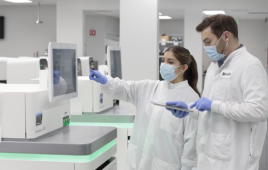 In a world first, neuroscientists at Flinders University have identified a series of chemical tools that can either increase or inhibit the release of neurotransmitters by neurons, the cells of the brain.
In a world first, neuroscientists at Flinders University have identified a series of chemical tools that can either increase or inhibit the release of neurotransmitters by neurons, the cells of the brain.
While not yet applied to a specific disease, the discovery has a wide range of potential pharmaceutical applications in neurological conditions ranging from schizophrenia to depression.
A team led by Associate Professor Damien Keating, a National Health and Medical Research Council (NHMRC) Research Fellow in the Department of Human Physiology and the Centre for Neuroscience at Flinders, has published a paper on the action of a protein called dynamin in the latest issue of the prestigious journal Molecular Psychiatry.
Vesicles – small spherical bodies within cells – contain active chemicals that can include neurotransmitters or hormones. Associate Professor Keating’s research is concerned with the process which sees vesicles move to the surface of a cell before opening a pore that allows the release of these active chemicals. The opening is then reversed and the vesicle moves back down into the cell to be reused.
Associate Professor Keating’s current research focuses on a protein named dynamin, already known to drive the process of resealing and recycling these vesicles. The breakthrough discovery has established that dynamin is also involved earlier in the process, and is a master regulator of the amount of neurotransmitter released from each vesicle.
Associate Professor Keating said the opening and closing of fusion pores – the vesicle’s temporary door through the cell wall – is dynamic, with differences in the size and duration of the opening controlling the amount of active chemical that is released.
Variations in levels of dynamin directly affect that process, and it is a process that underpins all our neuronal communication and hormone release, Associate Professor Keating said.
“If we activate dynamin, more is released by the vesicle; if we inhibit it, less is released,” he said. “This is fundamental new knowledge about a process that is essential to life in all organisms.”
Associate Professor Keating is collaborating with medicinal chemists and cell biologists in Sydney and Newcastle to further develop and refine these dynamin-based drugs.
“This research is novel in terms of identifying what this protein does – it plays a major new role that we did not know about – and it is novel in terms of the use of these drugs and their potential application,” he said.
“There is a lot work to be done to see how these drugs can be applied, but any neurological or metabolic disorder where neuronal or hormone signalling is a factor is a possible target, and any drug that can affect how much neurotransmitter or hormone is available has potential for usage in treatment,” he said.
Source: Flinders University
Filed Under: Genomics/Proteomics




